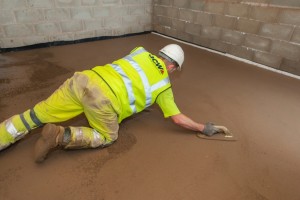Considerations Required Floor Screed Construction
Are you currently considering the floorscreeding requirements for your new home?
This can sometimes be a daunting task and it is important to understand the varying types of floor construction and materials that are available to you when deliberating over this important decision.
Firstly there are two types of ready mixed screed that will be available to you. These are as follows:
· Sand and Cement Screed
· Pumpable self smoothing screeds
There are several options available to you when using sand and cement screed. These are as follows:
· Bonded Screed (Minimum thickness 25mm by British Standard BS8204-1:2003+A1:2009)
This construction consists of the levelling screeds being laid directly to the concrete substrate on a polymer bonding agent or grout.
· Unbonded Screed (Minimum thickness 50mm by British Standard BS8204-1:2003+A1:2009)
This construction consists of the screed and the concrete being separated by a polythene layer/ DPM (Damp Proof Membrane)
· Floating Screed/ Screed on Underfloor Heating (Minimum thickness 65mm by British Standard BS8204-1:2003+A1:2009)
The floating screed construction consists of the screed being separated by both a polythene layer and some form of insulation board or resilient layer. It is the case that many who build their own houses opt for an underfloor heating system which can be incorporated into the floating construction between the insulation and the screed.
When using Pumpable self smoothing screed the constructions that are available are unbonded and floating. However this type of screed can be laid thinner than sand and cement as follows:
· Unbonded Construction – Minimum thickness 30mm
· Floating Construction – Minimum thickness 35mm
· Floating Construction incorporating Underfloor heating pipes – Minimum thickness 45mm (Minimum 25mm coverage over underfloor heating pipes)
All of the minimum thicknesses above are based on British Standard BS8204-7:2003
A floor screed is the perfect solution to provide a level base to lay a variety of floor finishes and sand and cement screed can be stepped where different floor finishes meet. For example if you have a 10mm tile in the kitchen but a 20mm wooden floor in the lounge the screed can be laid 10mm lower in the lounge so that the floor finishes run flush at the door threshold where they meet.
There are several pros and cons in the debate sand and cement versus pumpable self smoothing screed some of which are detailed below.
Sand/cement screed
Pros
- Cheaper in smaller areas
- More readily available countrywide
- Able to lay at differing levels
- Laid to falls in wet areas/bathrooms
- Dry’s quicker due to much lower water content
- Suitable for use with liquid DPMs
- Compatible with all cement adhesives
- Can be laid before the building is completely weather tight
Cons
- Small amount of cracking/ shrinkage to be expected
- Force drying not recommended
Liquid screed
Pros
- Screed pipes are encapsulated
- Up to 1000m2 poured in one day
- Very little cracking if any
- Can be force dried
Cons
- Extensive drying times
- Building needs to be fully weather tight before screed is laid
- Fully sealed floor preparation
- Not directly compatible with cement based adhesives
- Liquid DPM are not compatible
- Screed needs to be fully dry before floor coverings are applied
- Delays in material deliveries can result in problematic cold joint
We are specialist screed installers and specialize in Floor Screed Construction
Frequently Asked Questions
Floor screeding is the process whereby floor screed is applied to a floor surface to create a durable, heard wearing base for a final flooring – carpet, tiles, laminate etc.
Floor screeding is a popular method when it comes to creating a safe, level flooring that is suitable for a variety of final flooring options.
Typically, floor screed is made from a mixture of sand and cement.
Floors that have been screeded correctly tend to have an extended lifespan with improved quality.
Although a simple process, floor screeding does require a level of expertise and experience to ensure an excellent finished product.
To start with, your floor space will need to be cleared of all furniture, old flooring, dust and debris.
Once you’ve got your bare floor, your screeding professional will divide it into smaller sections using special dividers.
They will then apply the floor screed into these sections one at a time, starting with those furthest away from the door. As they’re adding the screed, they will make sure to compact the material – this is what gives it its toughness and durability.
Unless a self-levelling screed is used, the screeder will also make sure to level the screed by hand, section by section.
There are typically three types of floor screed to choose from, which is best will depend on your project:
Fibre reinforced floor screed
This popular type of screed is made from the usual sand and cement mixture, with an added synthetic fibre, polypropylene, mixed in. These added fibres hold the mix together whilst slightly slowing the drying rate, therefore helping to prevent cracking and shrinkage. This screed is great for enclosing underfloor heating as it is ideal for holding heat and stopping it from escaping.
Higher strength floor screed
Higher strength screed contains additives to give it extra strength , making it perfect for use in areas that get a lot of foot traffic or where heavy equipment will be kept – in a warehouse for example.
Fast drying floor screed
The additives mixed in with this floor screed reduce the amount of water needed to make the screed useable, therefore meaning the screed requires far less drying time. Light foot traffic can return after just two days and the final flooring can be laid after five days, meaning fast drying screed is great when you’re short on time and your final flooring needs to be laid quickly.
If you’re unsure which floor screed is best suited to your project, get in touch with our experts.
Typically, floor screed costs around £10-£35 per square metre. However, the price you will pay depends on your specific requirements.
The size of the area being screeded is the biggest influence on the final cost. The larger the area, the more screed is needed.
Your location also impacts the cost. The further away you are, the further we will have to transport your screed therefore fuel costs are considered.
Each screed is priced slightly differently, with higher strength floor screed costing slightly more than quick drying floor screed and fibre reinforced screed. Therefore, your choice of screed will also affect the price you pay.
It’s difficult for us to provide you with a quote without understanding your unique requirements first.
So, get in touch with us today to share your requirements and receive your fee, no obligation quote. Simply fill in our online form or email your architects drawings to estimating@jcwgroup.co.uk
With over 25 years of experience, we’re experts when it comes to floor screeding. Not only will you receive a competitive quote within 48 hours, but you can expect a high quality service from your first enquiry right through to the installation and aftercare advice.
We’re used to working to tight deadlines. Projects can start within 48 hours of your quote being received. We also work weekends and evenings were required to make sure we meet your important deadlines.
All the floor screed we supply is made in quality controlled plants and meets the European and British Standards. So, you can be sure you’re receiving the best possible product.
Plus, we only work with pre-mixed screed, so no one on your site will be exposed to excess dust which can cause respiratory issues when inhaled.
If you’ve got any questions about your project our team is on hand to provide advice and guidance.
Call us on 01204 387 029 or fill in our enquiry form.


